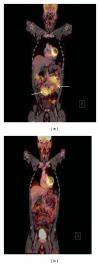18-Fluorodeoxyglucose Positron Emission Tomography/Computed Tomography in the Management of Aggressive Non-Hodgkin's B-Cell Lymphoma
- PMID: 22474590
- PMCID: PMC3313577
- DOI: 10.5402/2012/456706
18-Fluorodeoxyglucose Positron Emission Tomography/Computed Tomography in the Management of Aggressive Non-Hodgkin's B-Cell Lymphoma
Abstract
18-Fluorodeoxyglucose (FDG-PET/CT) is an established imaging modality that has been proven to be of benefit in the management of aggressive B-cell non-Hodgkin's lymphoma, such as diffuse large B-cell lymphoma and advanced stage follicular lymphoma. The combination of anatomic and functional imaging afforded by FDG-PET/CT has led to superior sensitivity and specificity in the primary staging, restaging, and assessment of response to treatment of hematological malignancies when compared to FDG-PET and CT alone. The use of FDG-PET/CT for posttreatment surveillance imaging remains controversial, and further study is needed to ascertain whether this modality is cost effective and appropriate for use in this setting.
Figures





Similar articles
-
Different roles of surveillance positron emission tomography according to the histologic subtype of non-Hodgkin's lymphoma.Korean J Intern Med. 2021 Mar;36(Suppl 1):S245-S252. doi: 10.3904/kjim.2019.376. Epub 2020 Jun 19. Korean J Intern Med. 2021. PMID: 32550718 Free PMC article.
-
Frequent impact of [18F]fluorodeoxyglucose positron emission tomography on the staging and management of patients with indolent non-Hodgkin's lymphoma.Clin Lymphoma. 2003 Jun;4(1):43-9. doi: 10.3816/clm.2003.n.013. Clin Lymphoma. 2003. PMID: 12837154
-
Whole-body positron emission tomography using 18F-fluorodeoxyglucose for posttreatment evaluation in Hodgkin's disease and non-Hodgkin's lymphoma has higher diagnostic and prognostic value than classical computed tomography scan imaging.Blood. 1999 Jul 15;94(2):429-33. Blood. 1999. PMID: 10397709
-
The role of 18F-FDG PET and 18F-FDG PET/CT in the evaluation of pediatric Hodgkin's lymphoma and non-Hodgkin's lymphoma.Hell J Nucl Med. 2013 Sep-Dec;16(3):230-6. doi: 10.1967/s0024499100091. Epub 2013 Oct 2. Hell J Nucl Med. 2013. PMID: 24137577 Review.
-
[The role of PET/CT investigation in the management of patients with diffuse large B-cell lymphoma].Magy Onkol. 2016 Jun 6;60(2):108-17. Epub 2016 Mar 23. Magy Onkol. 2016. PMID: 27275637 Review. Hungarian.
Cited by
-
Screening of trace elements in hair of the female population with different types of cancers in Wielkopolska region of Poland.ScientificWorldJournal. 2014;2014:953181. doi: 10.1155/2014/953181. Epub 2014 Dec 15. ScientificWorldJournal. 2014. PMID: 25580464 Free PMC article.
-
[¹⁸F]fluoro-2-deoxy-d-glucose positron emission tomography/computed tomography imaging in oncology: initial staging and evaluation of cancer therapy.Med Princ Pract. 2013;22(5):427-37. doi: 10.1159/000346303. Epub 2013 Jan 26. Med Princ Pract. 2013. PMID: 23363934 Free PMC article. Review.
-
Specialized second-opinion radiology review of PET/CT examinations for patients with diffuse large B-cell lymphoma impacts patient care and management.Medicine (Baltimore). 2017 Dec;96(51):e9411. doi: 10.1097/MD.0000000000009411. Medicine (Baltimore). 2017. PMID: 29390562 Free PMC article.
References
-
- Flowers CR, Armitage JO. A decade of progress in lymphoma: advances and continuing challenges. Clinical Lymphoma, Myeloma and Leukemia. 2010;10(6):414–423. - PubMed
-
- Jemal A, Siegel R, Xu J, Ward E. Cancer statistics, 2010. CA Cancer Journal for Clinicians. 2010;60(5):277–300. - PubMed
-
- Cronin CG, Swords R, Truong MT, et al. Clinical utility of PET/CT in lymphoma. American Journal of Roentgenology. 2010;194(1):W91–W103. - PubMed
LinkOut - more resources
Full Text Sources
